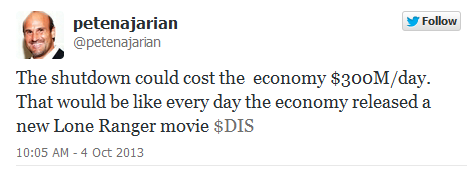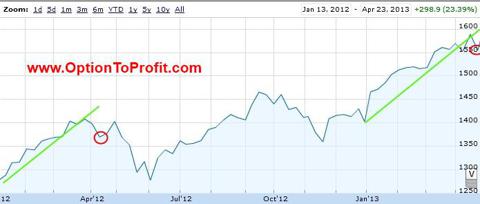 Sometimes good things can go good.
Sometimes good things can go good.
Anyone who remembers the abysmal state of television during the turn of this century recalls the spate of shows that sought to shock our natural order and expectations by illustrating good things gone bad. There were dogs, girls, police officers and others. They appealed to viewers because human nature had expectations and somehow enjoyed having those expectations upended.
That aspect of human nature can be summed up as “it’s fun when it happens to other people.”
For those that loved that genre of television show, they would have loved the stock markets of the last few years, particularly since the introduction of Quantitative Easing. That’s when good news became bad and bad news became good. Our ways of looking at the world around us and all of our expectations became upended.
Like everyone else, I blame or credit Quantitative Easing for everything that has happened in the past few years, maybe even the continued death of Disco. Who knew that pumping so much money into anything could possibly be looked at in a negative way despite having possibly saved the free world’s economies? While many decried the policy, they loved the result, in a reflection of the purest of all human qualities – the ability to hate the sinner, but love the sin.
Then again, I suppose that stopping such a thing could only subsequently be considered to be good, but rational thought isn’t a hallmark of event and data driven investing.
With so many believing that all of the most recent gains in the market could only have occurred with Federal Reserve intervention, anything that threatens to reduce that intervention has been considered as adverse to the market’s short term performance. That means good news, such as job growth, has been interpreted as having negative consequences for markets, because it would slow the flow. Bad news simply meant that the punch bowl would continue to be replenished.
For the very briefest of periods, basically lasting during the time that it wasn’t clear who would be the successor to Ben Bernanke, the market treated news on its face value, perhaps believing that in a state of leadership limbo nothing would change to upset the party.
It had been a long time since good news resulted in a market responding appropriately and celebrating the good fortune by creating more fortunes. This past week started with that annoying habit of taking news and believing that only a child’s version of reverse psychology was appropriate in interpreting information, but the week ended with a more adult-like response, perhaps a signal that the market has come to peace with idea that tapering is going to occur and is ready to move forward on the merits of news rather than conjecture of mass behavior.
As usual, the week’s potential stock selections are classified as being in Traditional, Double Dip Dividend, Momentum and “PEE” categories this week (see details).
Coming off a nearly 200 point advance on Friday what had initially looked like relative bargains were now pricey in comparison and at risk to retrace their advances.
While last week was one in which dividends were a primary source of my happiness, unfortunately this week is not likely to be the same. As in life where I just have to get by on my looks, this week I’ll have to get by on new purchases that hopefully don’t do anything stupid and have a reasonable likelihood of being assigned or having their calls rolled over to another point in the near future. The principle reason for that is that most of the stocks going ex-dividend this week that have some appeal for me only have monthly options available. Since I’m already overloaded on options expiring at the end of the this monthly cycle my interests are limited to those that have weekly options. With volatility and subsequently premiums so low, as much as I’d like to diversify by using expanded options, they don’t offer much solace in their forward week premiums.
While the energy sector may be a little bit of a mine field these days, particularly with Iran coming back on line, Williams Companies (WMB) fits the profile that I’ve been looking for and is especially appealing this week as it goes ex-dividend. Williams has been able to trade in a range, but takes regular visits to the limits of the range and often enough to keep its option premium respectable. With no real interest in longer term or macro-economic issues, I see Williams for what it has reliably been over the course of the past 16 months and 9 trades. Despite its current price being barely 6% higher than my average cost of shares, it has generated about 35% in premiums, dividends and share appreciation.
Another ex-dividend stock this week is Macys (M). Retail is another minefield of late, but Macys has not only been faring better than most of the rest, it has also just hit its year’s high this past week. Ordinarily that would send me in the opposite direction, particularly given the recent rise. With the critical holiday shopping season in full gear, some will have their hopes crushed, but someone has to be a winner. Macys has the generic appeal and non-descript vibe to welcome all comers. While I wouldn’t mind a quick dividend and option premium and then exit, it is a stock that I could live with for a longer time, if necessary.
Citibank (C) is no longer quite the minefield that it had been. It may be an example of a good stock, gone bad, now gone good again. When I look at its $50 price it reminds me of well known banking analysts Dick Bove, who called for Citibank to hold onto the $50 price as the financial meltdown was just heating up. Fast forward five years and Bove was absolutely correct, give or take a 1 to 10 reverse split.
But these days Citibank is back, albeit trading with more volat
ility than back in the old days. I’m under-invested in the financial sector, which didn’t fare well last week. If the contention that this is a market that corrects itself through its sector rotation, then this may be a time to consider loading up on financials, particularly as there are hints of interest rate rises. Citibank’s beta inserts some more excitement into the proposition, however.
Like many others, Dow Chemical (DOW) took its knocks last week before recovering much of its loss. Also like many that I am attracted toward, it has been trading in a price range and has been thwarted by attempts to break out of that range. Mindful of a market that is pushing against its highs, this is a stock that I don’t mind owning for longer than most other holdings, if necessary. The generous dividend helps the patient investor wait on the event of a price reversal. For those a little longer term oriented, Dow Chemical may also be a good addition for a portfolio that sells LEAPs.
Like all but one of this week’s selections, I have owned shares of International Paper (IP) on a number of occasions in the past year. While shares are now well off of their undeserved recent lows there is still ample upside opportunity and shares seemed to have created support at the $45 level. My preference, as with some other stocks on this week’s list is that a little of the past week’s late gains be retraced, but that’s not a necessary condition for re-purchasing International Paper.
Baxter International (BAX) has been also in a trading range of late having been boxed in by worries related to competition in its hemophilia product lines to concerns over the impact of the Affordable Care Act’s tax on medical devices. Also having recovered some of its past week’s losses it, too, is trading at the mid-point of its recent range and doesn’t appear to have any near term catalysts to see it break below its trading range. The availability of expanded options provide some greater flexibility when holding shares.
Joy Global (JOY) had been on an upswing of late but has subsequently given back about 5% from its recent high. It reports earnings this week and its implied price move is nearly 6%. However, its option pricing doesn’t offer premiums enhanced by earnings for any strike levels beyond that are beyond the implied move. While a frequent position, including having had shares assigned this past week, the risk/reward is not sufficient to purchase shares or sell puts prior to the earnings release. However, in the event hat shares do drop, I would consider purchasing shares if it trades below $52.50, as that has been a very comfortable place to initiate positions and sell calls.
LuLuLemon Athletica (LULU) on the other hand, has an implied move of about 8% and can potentially return 1.1% even if the stock falls nearly 9%. In this jittery market a 9% drop isn’t even attention getting, but a 20% drop , such as LuLuLemon experienced in June 2013 does get noticed. Its shares are certainly able to have out-sized moves, but it has already weathered quite a few challenges, ranging from product recalls, the announced resignation of its CEO and comments from its founder that may have insulted current and potential customers. I don’t expect a drop similar to that seen in December 2012, but can justify owning shares in the event of an earnings related drop.
Riverbed Technology (RVBD), long a favorite of mine, is generally a fairly staid company, as far as staying out of the news for items not related to its core business. It can often trade with some volatility, especially as it has a habit of providing less than sanguine guidance and the street hasn’t yet learned to ignore the pessimistic outlook, as RIverbed tends to report very much in line with expectations. Recently the world of activist investors knocked on Riverbed’s doors and they responded by enacting a “poison pill.” While I wouldn’t suggest considering adding shares solely on the basis of the prompting from activist investors, Riverbed has long offered a very enticing risk/reward proposition when selling covered calls or puts. It is one of the few positions that I sometimes consider a longer term option sale when purchasing shares or rolling over option contracts.
Finally, and this is certainly getting to be a broken record, but eBay (EBAY) has once again fulfilled prophecy by trading within the range that was used as an indictment of owning shares. For yet another week I had two differently priced lots of eBay shares assigned and am anxious to have the opportunity to re-purchase if they approach $52, or don’t get higher than $52.50. While there may be many reasons to not have much confidence in eBay to lead the market or to believe that its long term strategy is destined to crumble, sometimes it’s worthwhile having your vision restricted to the tip of your nose.
Traditional Stocks: Baxter International, Dow Chemical, eBay, International Paper
Momentum Stocks: Citibank, Riverbed Technology
Double Dip Dividend: Macys (ex-div 12/11), Williams Co (ex-div 12/11)
Premiums Enhanced by Earnings: Joy Global (12/11 AM), LuLuLemon Athletica (12/12 AM)
Remember, these are just guidelines for the coming week. The above selections may become actionable, most often coupling a share purchase with call option sales or the sale of covered put contracts, in adjustment to and
consideration of market movements. The overriding objective is to create a healthy income stream for the week with reduction of trading risk.


 This week I’m choosing “risk on.”
This week I’m choosing “risk on.” This is the time of year that one can start having regrets about the way in which votes were cast in prior elections.
This is the time of year that one can start having regrets about the way in which votes were cast in prior elections.  Pete Najarian put it in terms readily understandable, much more so than when some tried expressing the cost of a shutdown in terms of drag on quarterly GDP.
Pete Najarian put it in terms readily understandable, much more so than when some tried expressing the cost of a shutdown in terms of drag on quarterly GDP.









